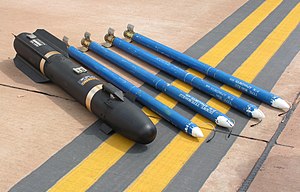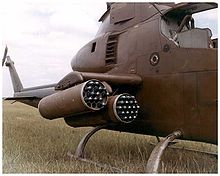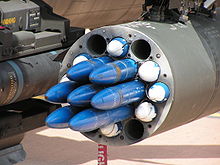Hydra 70
| Hydra 70 | |
|---|---|
 Four dummy Hydra 70 rockets and an inert AGM-114 Hellfire | |
| Type | rocket |
| Place of origin | United States |
| Service history | |
| Used by | United States, United Kingdom, Colombia, Japan, Kuwait, the Netherlands, Singapore, Thailand, and United Arab Emirates |
| Specifications | |
| Mass | 13.6 lb (6.2 kg)[dubious – discuss] |
| Length | 41.7 in (1,060 mm) |
| Diameter | 2.75 in (70 mm) |
| Muzzle velocity | 700 m/s (2,300 ft/s) |
| Effective firing range | 8,000 m (8,700 yd) |
| Maximum firing range | 10,500 m (11,500 yd) |
| Maximum speed | 2,425 ft/s (739 m/s) |
Guidance system | unguided |
Launch platform | AH-64 Apache, AH-1 Cobra, OH-58 Kiowa, Eurocopter Tiger |
The Hydra 70 rocket is a weapon derived from the 70 mm (2.75 inch) Mk 4/Mk 40 Folding-Fin Aerial Rocket developed by the United States Navy for use as a free-flight aerial rocket in the late 1940s.
Overview
The Hydra 70 family of WAFAR (Wrap-Around Fin Aerial Rocket), based on the Mk 66 universal motor, was developed from the previous 2.75 inch Mk 40 motor-based folding fin aerial rocket. The propellant grain is longer and of a different formulation than that of the MK40/MK4, however, the stabilizing rod and igniter are essentially the same design. The MK66 motors have a substantially higher thrust, 1335 lbs (Mod 2/3) 1415 lbs (Mod 4), and a longer range than the older motors. To provide additional stability the four rocket nozzles are scarfed at an angle to impart a slight spin to the rocket during flight. The Mk 40 was used during the Korean and Vietnam wars, beginning a rich history of providing close air support to ground forces from about 20 different firing platforms, both fixed-wing and armed helicopters, by all US armed forces. Today, the OH-58D(R) Kiowa Warrior and AH-64D Apache Longbow, as well as the Marine Corp's AH-1 Cobra, carry the Hydra rocket launcher standard on its weapon pylons.[1][2] The name Hydra is a reference to the beast of Greek mythology.
Mk 66 rocket motor variants
| Designation | Description |
|---|---|
| Mk 66 Mod 0 | 70 mm (2.75 in) WAFAR universal motor; common motor for the GD Hydra 70 series of rockets; original prototype; for US Army |
| Mk 66 Mod 1 | Mk 66 variant; production variant; for US Army |
| Mk 66 Mod 2 | Mk 66 Mod 1 variant; HERO (Hazards of Electromagnetic Radiation to Ordnance) safe; for US Navy and US Air Force |
| Mk 66 Mod 3 | Mk 66 Mod 1 variant; HERO safe; Mk 66 Mod 2 for US Army |
| Mk 66 Mod 4 | Mk 66 Mod 2/3 variant; incorporates a Salt rod to reduce exhaust gases; for all services |
| Mk 66 Mod 5 | Mk 66 Mod 4 variant; Incorporates propellant venting during fast cook off |
| Mk 66 Mod 6 | Mk 66 Mod 4/5 variant; designed to reduce the tendency of secondary launch gasses to combust in the parent aircraft’s engine, primarily with the AH-64 helicopter |
this is all wrong
Service

The family of Hydra 70 (70 mm) 2.75 inch rockets perform a variety of functions. The war reserve unitary and cargo warheads are used for anti-materiel, anti-personnel, and suppression missions. The Hydra 70 family of folding-fin aerial rockets also includes smoke screening, illumination, and training warheads. Hydra 70 rockets are known mainly by either their warhead type or by the rocket motor designation, Mk 66 in US military service.
USA
In the U.S. Army, Hydra 70 rockets are fired from the AH-64A Apache and AH-64D Apache Longbow helicopters using M261 19-tube rocket launchers, and the OH-58D Kiowa Warrior using seven-tube M260 rocket launchers. In the U.S. Marine Corps, either the M260 or M261 launchers are employed on the AH-1 Cobra and future AH-1Z Viper, depending upon the mission. The M260 and M261 are used with the Mk 66 series of rocket motor, which replaced the Mk 40 series. The Mk 66 has a reduced system weight and provides a remote fuze setting interface. Hydra 70s have also been fired from UH-60 and H-6 series aircraft in US Army service.
The AH-1G Cobra and the UH-1B "Huey" used a variety of launchers including the M158 seven-tube and M200 19-tube rocket launchers designed for the Mk 40 rocket motor; however, these models have been replaced by upgraded variants in the U.S. Marine Corps because they were not compatible with the Mk 66 rocket motor. The Hydra 70 rocket system is also used by the U.S. Navy, and the U.S. Air Force.
Hydra 70 rockets may also be used from the following fixed-wing platforms: A-4, A-6, A-7, AV-8B, A-10, F-4, F-16, F/A-18 and OV-10.
Common U.S. Mk 66 compatible launchers

| Designation | Description |
|---|---|
| M260 | 7-Tube LWL (LightWeight Launcher) |
| M261 | 19-Tube LWL (LightWeight Launcher) |
| LAU-130/A | 19-Tube rocket launcher |
| LAU-131/A | 7-Tube rocket launcher |
| LAU-68D/A | 7-Tube LAU-68C/A variant; compatible w/ Mk 66 rocket motor; external thermal protection coating; launcher supports single and ripple firing |
| LAU-61C/A | 19-Tube LAU-61B/A variant; compatible w/ Mk 66 rocket motor; external thermal protection coating; launcher supports single and ripple firing |
Warheads
Hydra 70 warheads fall into three categories:
- Unitary warheads with impact-detonating fuses or remote-set multi-option fuses.
- Cargo warheads with air burst-range, with setable fuses using the "wall-in-space" concept or fixed standoff fuses.
- Training warheads.
Fusing options
| # | Designation | Description | Arming Range, Acceleration or Time |
|---|---|---|---|
| 1 | M423 | Nose Mount, Point Detonating for slow speed platforms (helicopters) | 43 to 93m |
| 2 | M427 | Nose Mount, Point Detonating for high speed platforms | 180 to 426m |
| 3 | XM436 | Air burst, Motor-Burnout Delay | |
| 4 | XM438/M438 | Nose Mount, Point Detonating | |
| 5 | M440 | Point Detonating | |
| 6 | Mk 352 Mod 0/1/2 | Point Detonating | |
| 7 | M429 | Proximity Air burst | |
| 8 | M433 | Nose Mount, Resistance Capacitance (RC) | SuperQuick (PD) 10 to 45m Delay in 5m increments including 3m Bunker penetrating option |
| 9 | M439 | Base Mount, Resistance Capacitance (RC), Payload Discharging Pilot-Selectable | Discharges SMs between 500 and 7200m (700 to 6900m on AH-1s) 27Gs |
| 10 | M442 | Air burst, Motor-Burnout Delay | Discharges Flare at 3000m, 17-22G required for arming |
| 11 | M446 | Base Mount, Air burst, Motor-Burnout Delay | |
| 12 | Model 113A | Base Mount, Air burst, Motor-Burnout Delay |
Common warheads
| Designation | Description | Weight | Payload | Fuse Type | Fusing options |
|---|---|---|---|---|---|
| M151 | High explosive (HEPD) '10 pounder' | 9.3 lbs (4.2 kg) | 2.3 pounds Comp B-4 HE | M423 | 1,2,5,7,8 |
| M156 | White phosphorus (WP) | 9.65 lbs (4.38 kg) | 2.2 lbs (1.0 kg) WP | M423 M429 | 1,2,6,7 |
| M229 | High explosive (HEPD); elongated M151 '17 pounder' | 17.0 lbs (7.7 kg) | 4.8 pounds Comp B-4 HE | M423 | 1,2,6,7 |
| XM245 | Submunition warhead possibly a modernized XM80/XM99 | 32 XM100 CS canisters | 3 | ||
| M247 | High-explosive anti-tank (HEAT)/high-explosive dual purpose (HEDP) | 8.8 lbs (4.0 kg) | 2.0 lbs Comp B HE | M438 PD | 4 (integral to warhead) |
| M255 | APERS warhead | 2500 28 grain (1.8 g) flechettes | 9 | ||
| M255E1/A1 | Flechette warhead | 14.0 lbs (6.4 kg) | 1179 60 grain (3.8 g) flechettes | M439 | 9 |
| M257 | Parachute illumination | 11.0 lbs (5.0 kg) | One M257 Candle (Flare) 1 million candela | M442 | 10 (integral to warhead) |
| M259 | White phosphorus (WP) | 9 | |||
| M261 | Multi-purpose submunition (MPSM) | 13.5 lbs (6.1 kg) | 9 M73 (Grenade) Submunitions | M439 with M84 electric detonator | 9 |
| M264 | Red phosphorus (RP) Smoke | 8.6 lbs (3.9 kg) | 72 RP Pellets | M439 | 9 |
| M267 | MPSM Practice | 13.5 lbs (6.1 kg) | Three Marking SMs, 6 Metal Weights | M439 with M84 electric Detonator | 9 |
| M274 | Practice (Smoke) | 9.3 lbs (4.2 kg) | 2 ounces of potassium perchlorate and aluminum powder | M423 | 1 |
| M278 | Infra-red (IR) parachute illumination | 11.0 lbs (5.0 kg) | One M278 IR Flare | M442 | 10 (integral to warhead) |
| Mk 67 Mod 0 | White phosphorus (WP) | 1,2,6,7 | |||
| Mk 67 Mod 1 | Red phosphorus (RP) | 1,2,6,7 | |||
| WTU-1/B | Practice | 9.3 lbs (4.2 kg) | Inert | None | None |
| WDU-4/A | APERS warhead | 9.3 lbs (4.2 kg) | 96 flechettes of unknown weight | 12 (integral to warhead) | |
| WDU-4A/A | APERS warhead | 9.3 lbs (4.2 kg) | 2205 20 grain (1.3 g) flechettes | 12 (integral to warhead) |
NOTE: Though some of the warheads described were designed for the older Mk 40 rocket motor, but most likely could work with the Mk 66 motor if upgraded or modernized models were not available. However, this would not be necessary, as vast quantities of upgraded models exist today. [citation needed]
Mk 66 rocket motor technical data
Weight: 13.6 lb
Length: 41.7 in (1.06 m)
Burn time: 1.05 - 1.10 sec
Average thrust (77 F): 1,335 lb (Mod 2/3) 1,415 lb (Mod 4)
Motor burnout range: 1,300 ft (397 m)
Motor burnout velocity: 2,425 ft/s (739 m/s)
Launch spin rate: 10 rps, 35 rps after exiting launcher
Velocity at launcher exit: 148 ft/s (45 m/s)
Acceleration: 60-70 g (initial) 95-100 g (final)
Effective Range: 500 to 8,000 m depending on warhead and launch platform
Maximum Range: 10,500 m under optimum conditions
Precision guided Hydra 70
The Advanced Precision Kill Weapon System (APKWS) II is a program to provide a laser guided missile that is compatible with the existing Hydra 70 systems in service. It was cancelled by the US Army in February 2007,[3] but was restarted by the US Navy in 2008. Similar programs are the US Navy Low-Cost Guided Imaging Rocket, Lockheed Martin Direct Attack Guided Rocket and the ATK/Elbit Guided Advanced Tactical Rocket – Laser.
See also
References
External links
- "Hydra 70". GlobalSecurity. Retrieved 2005-09-01.
- Hydra-70 Rockets: From Cutbacks to the Future of Warfare, Defense Industry Daily, 2006-4
{{citation}}: Check date values in:|date=(help). - Air-Launched 2.75-Inch Rockets, Designation Systems.
- "Hydra-70", Warheads energetics, Weapon Systems, General Dynamics.
- 2012 Army Weapon Systems Handbook
